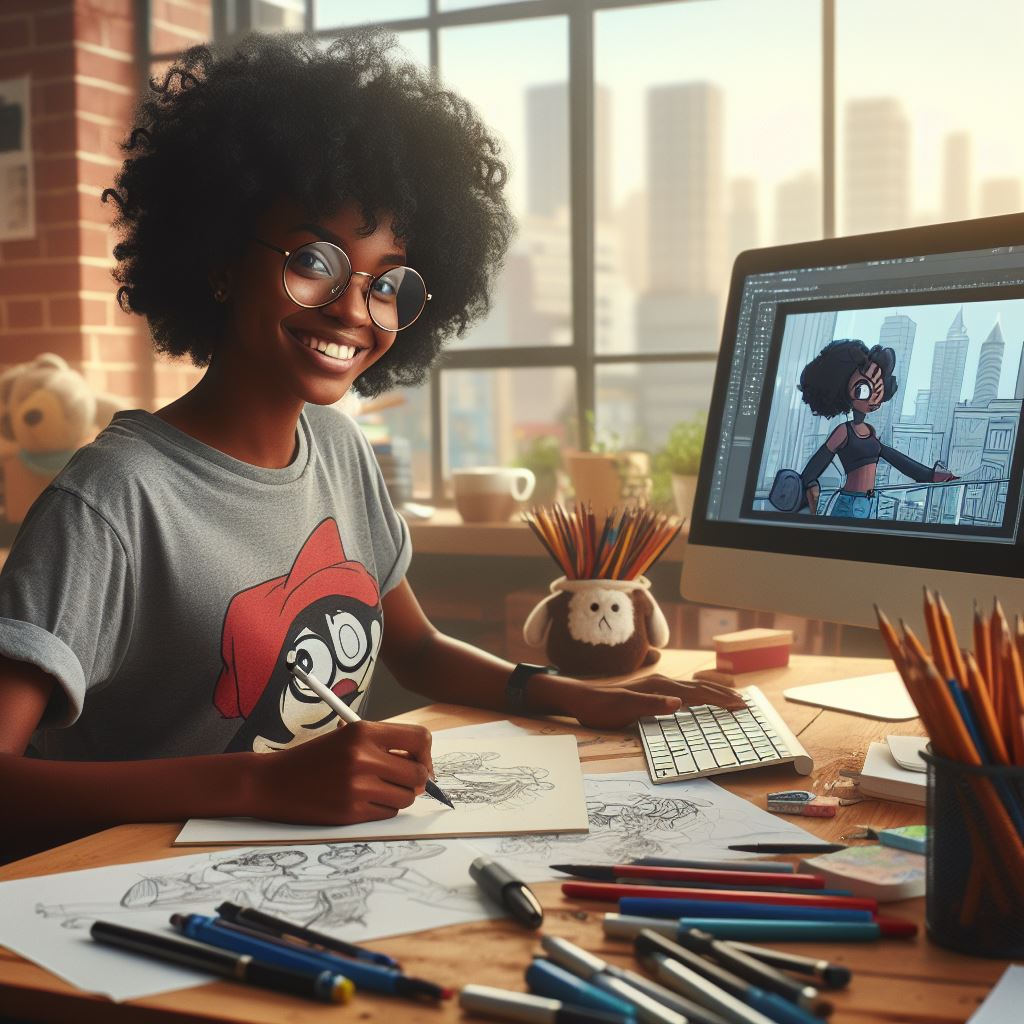Introduction
Embark on a comprehensive exploration of productivity hacks specifically designed to empower and streamline the creative process.
Within the expansive realm of artistic endeavors, there exists a crucial need to unravel the intricacies of maximizing efficiency.
This journey not only underscores the necessity of productivity but also serves as a beacon for creatives seeking to navigate the delicate balance between inspiration and output.
At the heart of this discourse lies the profound importance of uncovering strategies that transcend conventional approaches, offering creatives a unique toolkit to enhance their workflow.
The relentless pursuit of creative excellence often calls for a nuanced understanding of productivity, prompting an insightful investigation into methodologies that go beyond the generic.
It is within this context that we confront the challenges distinctive to the creative realm.
The labyrinth of artistic expression, with its twists and turns, demands a heightened awareness of the hurdles that creatives encounter.
Be it the perpetual dance between inspiration and deadlines or the intricacies of translating vision into tangible form, creatives face a myriad of challenges that demand tailored solutions.
In review, this exploration serves as an invitation to delve deep into the nuanced landscape of creative productivity.
It beckons creatives to not only recognize the hurdles they face but to actively seek out and implement innovative solutions.
Navigating artistic pursuits reveals the need for bespoke productivity hacks. These unlock creatives’ full potential in crafting their art.
Understanding Creativity and Productivity
What it means to be a creative and the nature of their work
To truly grasp the concept of productivity hacks for creatives, it is essential to first define what it means to be a creative and understand the nature of their work.
Creatives are individuals who possess the ability to think outside the box, come up with new ideas, and produce original and innovative work.
The relationship between creativity and productivity
Creativity and productivity go hand in hand. While creativity is about generating ideas and inspiration, productivity is about turning those ideas into tangible results.
Without productivity, creativity remains just a concept, and without creativity, productivity lacks innovation and originality.
Common misconceptions about productivity in creative field
In creative fields, there are often misconceptions about productivity.
People tend to believe that being productive means cranking out a certain quantity of work, regardless of its quality.
However, for creatives, the focus should be on producing high-quality work that meets their standards of excellence.
Another misconception is that creativity cannot be enhanced or improved. Many believe that creativity is innate and cannot be cultivated.
However, with the right mindset and practices, anyone can develop and enhance their creative abilities.
The importance of balancing creativity and productivity
Productivity hacks for creatives should emphasize the importance of finding a balance between creativity and productivity.
Pushing oneself too hard to be productive can stifle creativity, resulting in burnout and a lack of inspiration.
On the other hand, getting lost in creative pursuits without any structure or direction can hinder productivity.
Effective productivity hacks
Here are some effective productivity hacks for creatives:
- Establish a routine: Set aside dedicated time each day for creative work. Having a consistent schedule helps train your brain to be creative during those specific hours.
- Break tasks into smaller steps: Large projects can appear overwhelming, leading to procrastination. Breaking them down into smaller, manageable tasks makes it easier to tackle and increases productivity.
- Set realistic goals: Set achievable goals that motivate you to stay productive. This could be completing a certain number of sketches or finishing a section of a novel within a specific timeframe.
- Eliminate distractions: Find a quiet and clutter-free workspace, turn off notifications on your phone, and block distracting websites to stay focused on your creative work.
- Take breaks: Regular breaks are essential for maintaining productivity. Step away from your work, go for a walk, or engage in a different activity to recharge your mind and prevent burnout.
- Collaborate and seek feedback: Working with others and seeking feedback can stimulate creativity and help improve your work. Collaboration provides fresh perspectives and ideas that you may not have considered otherwise.
- Embrace failure: Failure is an inevitable part of the creative process. Instead of being deterred by it, view failure as a learning opportunity that allows you to grow and improve.
- Practice self-care: Take care of your physical and mental well-being. Prioritize sleep, exercise regularly, and engage in activities that rejuvenate your mind and inspire creativity.
Implementing these productivity hacks enhances creatives’ workflow, maintains inspiration, and ensures their best work. Productivity optimizes the creative process for excellence, not just completing tasks.
Identifying Personal Productivity Challenges
In the fast-paced world of creativity, productivity is essential for success. However, creatives face unique challenges that can hinder their ability to stay productive.
Challenges
In this section, we will discuss some of these challenges and how to overcome them.
Creative Blocks
One of the most common productivity challenges faced by creatives is creative blocks. These blocks can be caused by a lack of inspiration or a feeling of being stuck in a rut.
To overcome this, it’s important to take breaks, explore new ideas, and find inspiration in different places.
Distractions
In today’s digital age, distractions are everywhere. Social media, emails, and other notifications can easily divert our attention and make it difficult to focus on our creative tasks.
To combat this, it’s crucial to create a distraction-free environment, turn off notifications, and set specific periods of uninterrupted work time.
Lack of Motivation
Another challenge faced by creatives is a lack of motivation. Being creative requires a certain level of passion and drive, and it’s not uncommon to feel unmotivated at times.
To boost motivation, it’s helpful to set clear goals, break tasks into smaller, manageable steps, and find ways to reignite the passion for your craft.
Assessing Your Personal Productivity Challenges
While the challenges mentioned above are common among creatives, it’s important to recognize that each person’s productivity hurdles may differ.
To identify your own challenges, take some time for self-reflection and awareness.
Personalized Financial Consulting – Tailored for You
Get a custom financial plan made just for you in 1-3 days. Clear strategies, actionable steps, and unlimited revisions.
Get StartedKeep a Journal
A journal can be a valuable tool for understanding your productivity patterns. Take note of the times when you feel most productive, as well as the moments when you struggle.
This will help you identify any recurring challenges or triggers.
Analyze Your Environment
Consider the physical and mental environments in which you work.
Identify distractions and triggers impacting productivity. Note peak focus times. Optimize your work environment for enhanced productivity.
Seek Feedback
Ask for feedback from colleagues, mentors, or friends who know you well. They may have insights into your working habits and offer suggestions for improvement.
Sometimes, an outside perspective can shed light on productivity challenges we may have overlooked.
The Importance of Self-Reflection and Awareness
Self-reflection and awareness are essential for overcoming productivity challenges because they allow us to identify areas for improvement and develop effective strategies.
By understanding our own strengths, weaknesses, and work patterns, we can optimize our creative output.
In essence, identifying personal productivity challenges is the first step towards becoming a more productive creative.
To overcome obstacles like creative blocks and distractions, acknowledge them, reflect on solutions, and boost productivity through self-awareness exercises.
Establishing Effective Goals and Priorities
Setting clear goals and priorities is crucial for creatives to maximize their productivity and achieve success.
By aligning their goals with their creative vision, they can stay focused, motivated, and on track.
Explore the importance of establishing clear goals, align your creative vision with objectives, use SMART goals, and prioritize tasks based on deadlines.
The Significance of Setting Clear Goals and Priorities
Setting clear goals and priorities is like having a roadmap that leads creatives to their desired destination.
Without clear goals, creatives may find themselves lost, lacking direction, and easily distracted.
Goals act as guiding principles, allowing creatives to prioritize their time and efforts effectively.
Moreover, setting clear goals provides a sense of purpose and motivation.
When creatives have a clear vision of what they want to achieve, they are more likely to stay committed and focused on their tasks.
It helps them overcome obstacles and push through challenges, knowing that their efforts are leading them closer to their desired outcome.
Aligning Goals with Creative Vision
For creatives, aligning their goals with their creative vision is essential for staying authentic and true to themselves.
It ensures that their goals are not only meaningful but also resonate with their passion and purpose.
By aligning goals with their creative vision, creatives create a sense of harmony and fulfillment in their work.
One effective way to align goals with creative vision is by regularly evaluating and reflecting on oneself.
Creatives should ask themselves what truly inspires them, what they want to achieve, and how their goals align with their long-term vision.
By connecting their goals with their creative aspirations, they can ensure that their efforts are focused on what matters most to them.
Tips on Setting SMART Goals
Setting SMART goals is a proven strategy that helps creatives establish clear and actionable objectives. SMART stands for Specific, Measurable, Achievable, Relevant, and Time-Bound.
Here are some tips to apply the SMART framework:
- Be Specific: Clearly define what you want to achieve. Avoid vague goals.
- Make it Measurable: Set quantifiable criteria to track your progress and success.
- Ensure it’s Achievable: Set realistic goals that are within your capabilities and resources.
- Keep it Relevant: Align your goals with your creative vision and long-term aspirations.
- Set Time-Bound Deadlines: Assign specific deadlines to create a sense of urgency and accountability.
By setting SMART goals, creatives can break down their big aspirations into smaller, actionable steps, making them more achievable and manageable.
Prioritizing Tasks Based on Goals and Deadlines
Once creatives have established their goals, it’s crucial to prioritize tasks based on their importance and deadlines.
By prioritizing tasks, creatives ensure that they invest their time and energy into activities that contribute directly to their goals.
A helpful technique for prioritizing tasks is the Eisenhower Matrix.
It categorizes tasks into four quadrants: Urgent and Important, Important but not Urgent, Urgent but not Important, and Neither Urgent nor Important.
By focusing on tasks in the Urgent and Important quadrant, creatives can avoid distractions and maintain their productivity.
In fact, establishing effective goals and priorities is an essential productivity hack for creatives.
By setting clear goals, aligning them with their creative vision, setting SMART objectives, and prioritizing tasks accordingly, creatives can increase their productivity and bring their creative vision to life.
Read: Build an Online Course Easily
Managing Time and Energy
Effective time management techniques for creatives
In order to be productive as a creative, effective time management techniques are essential. Here are some strategies that can help:
- Create a to-do list: Write down all the tasks you need to accomplish for the day, and prioritize them.
- Use time blocking: Allocate specific time slots for different activities, ensuring you have dedicated creative time.
- Avoid multitasking: Focus on one task at a time to maintain productivity and prevent overwhelm.
- Set realistic deadlines: Break down bigger projects into smaller milestones and assign deadlines to stay on track.
- Utilize productivity apps: Explore apps like Trello, Todoist, or Evernote to keep track of tasks and deadlines.
The importance of scheduling and setting aside dedicated creative time
Aside from managing time effectively, it is also crucial to take care of your energy levels:
Unlock Your Path to Financial Freedom
Personalized savings and investment strategies tailored to your financial goals. Let's help you take control of your future with a plan designed just for you.
Get Started- Take regular breaks: Short breaks can replenish energy and prevent burnout. Use the Pomodoro Technique (working for 25 minutes, then taking a 5-minute break) to stay focused.
- Practice self-care: Engage in activities that relax and rejuvenate you, like exercising, meditating, or pursuing hobbies.
- Avoid energy vampires: Identify tasks or situations that drain your energy and find ways to minimize or delegate them.
- Get enough sleep: Restorative sleep is crucial for maintaining energy levels and overall well-being.
The benefits of establishing a routine and maintaining a work-life balance
In addition to managing time and energy levels, establishing a routine and maintaining work-life balance can significantly boost productivity:
- Establish a daily routine: Having a structured routine helps create a sense of stability and reduces decision fatigue.
- Set boundaries: Clearly define your work hours and allocate specific time for personal activities, ensuring a healthy work-life balance.
- Avoid overcommitting: Learn to say no to tasks or projects that do not align with your priorities or contribute to your long-term goals.
- Delegate and outsource: Identify tasks that can be delegated to others or consider outsourcing certain responsibilities to free up your time for creative work.
Strategies for managing energy levels, such as taking breaks and practicing self-care
Managing time and energy efficiently as a creative can lead to several benefits:
- Increased productivity: Implementing these techniques allows for more focused and efficient work, resulting in higher output.
- Reduced stress: By effectively managing time, energy, and establishing a routine, stress levels can be minimized.
- Enhanced creativity: Dedicated creative time allows for deeper immersion in creative projects, fostering inspiration and innovation.
- Improved work-life balance: Balancing work and personal life ensures a healthier and more fulfilling lifestyle.
- Greater satisfaction: Meeting deadlines, achieving creative goals, and maintaining a balanced life contribute to a sense of accomplishment and overall satisfaction.
In summary, managing time and energy as a creative is crucial for productivity and overall well-being.
Implementing effective time management, boosting energy, establishing routines, and balancing work and life unlock creatives’ potential for consistently producing their best work.
Read: LinkedIn for Nigerian Professionals

Find Out More: Project Management Essentials
Minimizing Distractions and Fostering Focus
Identify Common Distractions that Affect the Productivity of Creatives
- Notifications from social media platforms can easily divert attention from creative tasks.
- Environmental noise and interruptions from colleagues can disrupt concentration.
- Cluttered workspaces can cause mental clutter and hinder productivity.
- Multitasking, while tempting, often leads to decreased focus and efficiency.
- External factors like personal stress or unresolved issues can affect creative flow.
Suggest Practical Ways to Minimize or Eliminate Distractions
- Disable notifications or use apps to limit access to social media during work periods.
- Consider noise-canceling headphones or find a quieter area to work in.
- Organize and declutter your workspace regularly to create a more conducive environment.
- Practice deep work by focusing on one task at a time rather than multitasking.
- Create a to-do list and address personal issues or concerns before starting creative work.
Setting Boundaries, Creating a Dedicated Workspace, and Implementing Time-Blocking Techniques
Setting boundaries is crucial to minimize distractions and maintain focus on creative work. Examples include:
- Establishing specific work hours and communicating them to colleagues and family members.
- Designating a separate room or area solely for creative work to minimize interruptions.
- Utilizing time-blocking techniques, such as the Pomodoro Technique, to break work into focused intervals.
Creating a dedicated workspace helps signal the brain that it’s time for focused work, enhancing productivity and concentration.
Implementing time-blocking techniques encourages efficient use of time, ensuring creativity receives appropriate attention.
Tips on Improving Focus and Concentration During Creative Work Sessions
- Set clear goals before each session to provide direction and give your mind a purpose.
- Eliminate background distractions by turning off unnecessary notifications or electronic devices.
- Take short breaks to recharge and refresh your mind, enhancing overall focus.
- Practice mindfulness techniques, such as deep breathing or meditation, to improve concentration.
- Engage in regular physical activity to boost mental clarity and focus during creative work.
By identifying distractions, implementing practical strategies, and nurturing focus, creatives can maximize productivity and achieve their creative potential.
Read: Powerful Public Speaking Tips
Boosting Creativity and Inspiration
In today’s fast-paced world, maintaining a high level of creativity can be a challenge for many creatives.
However, there are several strategies that can be used to enhance creativity and find inspiration.
By cultivating a creative mindset through practices such as journaling, meditation, and seeking new experiences, creatives can unlock their full potential.
Strategies to enhance creativity and find inspiration
One effective strategy for boosting creativity is keeping a journal.
Regularly writing down thoughts, ideas, and observations can help clear the mind and create space for new and innovative ideas to emerge.
Additionally, writing can be a form of self-reflection, allowing creatives to gain new insights into their own thought processes and creative patterns.
Cultivate a creative mindset through practices
Meditation is another powerful tool for enhancing creativity.
Taking a few minutes each day to sit in silence and focus on the breath can help calm the mind and tap into a deeper level of creativity.
During meditation, new ideas can surface and connections between seemingly unrelated concepts can be made.
Seeking new experiences is also essential for stimulating creativity.
Stepping out of one’s comfort zone and exploring different environments, cultures, and art forms can provide a fresh perspective and spark inspiration.
Whether it’s traveling to a new city or trying out a new artistic medium, exposing oneself to new stimuli can open up new pathways for creative thinking.
Stimulating creativity
Collaboration is another effective method for stimulating creativity.
By working with other creatives, ideas can be shared, combined, and expanded upon.
Collaborating with individuals who have different perspectives and skill sets can lead to innovative solutions and breakthroughs.
Whether it’s joining a creative community, attending workshops, or participating in group projects, seeking out collaboration opportunities can be highly beneficial for stimulating creativity.
Take Control of Your Debt Today
Struggling with debt? Get personalized strategies to pay off your debts, negotiate with creditors, and rebuild your credit. Your path to financial freedom starts here.
Get HelpThe importance of self-care for maintaining a healthy creative output
While it’s important to focus on enhancing creativity, it’s equally important to prioritize self-care.
Taking care of one’s physical and mental well-being is crucial for maintaining a healthy creative output.
This can include practicing self-compassion, getting enough sleep, eating nutritious foods, and engaging in regular exercise.
Engaging in activities that bring joy and relaxation, such as spending time in nature or practicing a hobby, can also help recharge the creative mind.
To sum it up, boosting creativity and finding inspiration is essential for any creative individual.
By incorporating strategies such as journaling, meditation, seeking new experiences, and collaborating with others, creatives can enhance their creative output.
Additionally, prioritizing self-care is crucial for maintaining a healthy and sustainable creative practice.
By adopting these practices, creatives can unlock their full creative potential and continue to produce high-quality work.
Read: Sales Funnel Strategies Uncovered
Conclusion
In this blog post, we discussed several key productivity hacks for creatives.
We explored strategies such as setting goals, prioritizing tasks, and creating a conducive work environment.
Implementing these strategies is crucial for enhancing productivity as creatives.
It is vital for creatives to recognize the importance of these productivity hacks and make a conscious effort to incorporate them into their daily routines.
By doing so, they can optimize their workflow, increase their output, and achieve their creative goals more efficiently.
While the strategies mentioned in this blog post are proven to be effective, it is essential for readers to experiment with different techniques and find what works best for them.
Each creative individual has unique preferences and working styles, so it is crucial to find a personalized approach that suits their needs.
In the end, improving productivity as a creative requires dedication, discipline, and a willingness to try new strategies.
By implementing the productivity hacks discussed in this blog post, readers can take significant steps towards enhancing their creative output and achieving their goals.
Remember, small changes can make a big difference, so start implementing these productivity hacks today and watch your creativity soar to greater heights!




